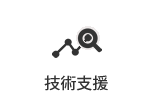本文
No.8(2005)3.The Application of Chelating Resin to the Elimination of Interferences in the Analysis of Trace Hazardous Elements
Masao YAMAZAKI, Michiko GOTO, Seiko NAKAGAWA, Ryouichi HUKUCHI, Sadaharu SHIRAKO
In general, digestion with nitric and sulfuric acids are applied in the analysis of trace elements in solid materials like industrial products and soils. This causes the digested solution to contain high concentrations of sulfate ion. In addition, silicate, chloride and other interferences, which are contained in the material itself, can also be included. These interfering matrices are separated generally through solvent extraction. In stead of the solvent extraction method, we applied the solid phase extraction method using chelating resin, which has a functional group of iminodiacetic acid, for the analysis of trace hazardous metals such as Cd and Pb in industrial products, soils, and other materials containing high concentrations of matrix components. In the presence of high concentrations of interfering ions, over 80% of Cd and Pb were extracted, with one exception that the recovery of Cd from seawater decreased to 60-30% in the presence of 19g/L of chloride ion. On the other hand, Cr, As, and Se were extracted at a low recovery rate with this type of chelating resin.
Keywords
Trace element, Cadmium, Lead, Chelating resin, Solid phase extraction













